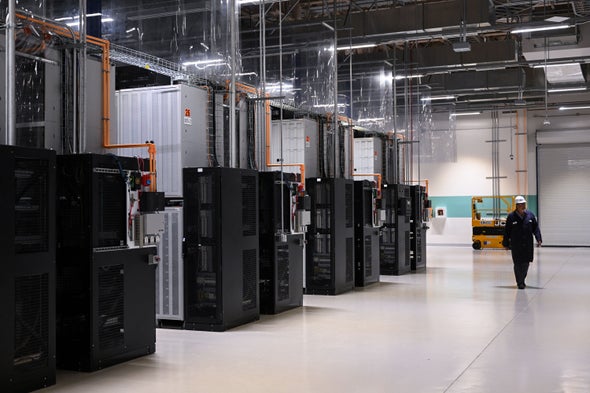The United States is in a battery boom, adding nearly as much capacity on the power grid in 2022 as it did in all previous years combined.
The surge is reshaping America’s regional electric grids. In California, for example, analysts credit a wave of new battery installations with sparing the state from electric blackouts late last summer, when a searing heat wave sent power demand soaring.
“It means we can move the energy generated by wind and solar to when it is needed, like moving solar generated during the day to the evening when everyone comes home and turns on their air conditioning,” said Ric O’Connell, the executive director of GridLab. “It is enabling us to rely more and more on wind and solar.”
The United States installed 4 gigawatts of battery capacity in 2022, nearly matching the 4.7 GW installed in all previous years combined, according to U.S. Energy Information Administration figures. California and Texas accounted for 90 percent of U.S. battery installations, bringing online 2.4 GW and 1.3 GW, respectively, in 2022.
The battery explosion in America’s two most populous states is largely due to the growing strength of solar. California and Texas are the first- and second-largest solar markets in the United States, respectively, by some distance.
The high penetration of solar in each state contributes to large swings in electricity prices, which fall during the day when solar is producing and surge in the evening when demand rises and solar production falls off.
Batteries are well-placed to profit from the price surge during the evening hours. Lithium-ion batteries, which account for the vast majority of utility-scale energy storage installations, can charge quickly using surplus solar generation during the daytime hours and dispatch power over a four-hour interval in the evening.
“You’re really chasing arbitrage,” said Dan Finn-Foley, an analyst who tracks the storage industry at PA Consulting. “Storage can capture a lot of value there.”
The sheer scope of America’s energy storage boom is stunning, he said. In 2018, the United States installed a total of 189 megawatts of storage capacity. Last year, the largest single installed project was 350 MW, according to the American Clean Power Association, a trade group.
The growth is not surprising, Finn-Foley said. The lithium-ion batteries used for grid purposes are the same batteries used in electric vehicles. As the EV market has grown, it has scaled up supply chains and driven down battery costs for grid-scale storage. Batteries used in the power sector make up a small part of the overall lithium-ion battery market.
“It is safe to say that the stationary grid storage industry would not exist today without the EV industry,” Finn-Foley said.
The flood of battery installations in the power sector in 2022 is especially notable given the supply chain constraints the industry faced in the first part of the year. Developers were largely able to work through those issues after experiencing similar supply chain crunches in 2018 and 2020, Finn-Foley said.
The impact of the new installations was especially apparent during a Labor Day heat wave in California last year. The state was able to call on roughly 3 GW of battery capacity during the evening hours, when demand was near its peak and solar production had fallen off, O’Connell said.
“Without that 3 GW of storage online, we would have been in significant trouble,” he said. Even with that battery capacity, soaring demand prompted the state's grid operator to ask residents to cut back on their electricity use to prevent blackouts.
Analysts said the battery boom is likely to continue.
The Inflation Reduction Act, the sweeping climate law enacted last year, makes it easier for battery developers to claim an investment tax credit. Previously, a battery installer needed to be connected to a solar project to qualify. The Inflation Reduction Act removed that requirement, paving the way for any battery connected to the grid to qualify.
Between now and 2026, developers plan to install 22 GW of battery capacity, according to EIA figures. Of that, 16 GW is slated for Texas and California.
Reprinted from E&E News with permission from POLITICO, LLC. Copyright 2023. E&E News provides essential news for energy and environment professionals.


